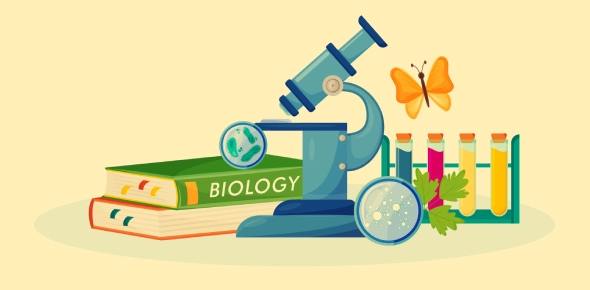General Biology Macromolecules, DNA, and Cell Basics: A Complete Guide with Real-World Relevance
Lesson Overview
- What Are the Four Major Macromolecules and Their Functions?
- What Are Carbohydrates Made Of and How Are They Classified?
- How Do Monomers and Polymers Relate in Macromolecules?
- What Happens During Dehydration Synthesis and Hydrolysis?
- What Are Proteins and How Are They Built?
- What Happens When a Protein Is Denatured?
- What Are the Key Characteristics of Lipids?
- How Is DNA Structured and What Are Its Components?
- What Are the Nitrogenous Bases and Their Pairing Rules?
- What Is ATP and Why Is It Important for Cells?
- Why Is Carbon Central to Organic Chemistry?
- What Are Hydrocarbons and Are They Water-Soluble?
- What Are Isomers and Why Are They Important?
When Jason struggled to explain how proteins form or how DNA stores information, he realized he didn't fully understand the core concepts of General Biology. This lesson breaks down those foundational ideas, like macromolecules, enzymes, and energy molecules, into clear, simple terms to build a strong, lasting understanding of life's essential processes.
What Are the Four Major Macromolecules and Their Functions?
Let's start with the basics. This section covers the four essential macromolecules that make up all living things: carbohydrates, proteins, lipids, and nucleic acids. Each plays a unique role in structure and function within the body.
- Carbohydrates provide energy and structural support.
- Proteins perform countless functions from enzymes to muscle building.
- Lipids store energy, provide insulation, and make up cell membranes.
- Nucleic acids (DNA and RNA) store and transfer genetic information.
What Are Carbohydrates Made Of and How Are They Classified?
Carbohydrates are built from sugar molecules. This section breaks down their types: monosaccharides, disaccharides, and polysaccharides, and explains their biological importance.
- Monosaccharides are single sugars like glucose and fructose.
- Disaccharides are two sugars linked together, like sucrose and lactose.
- Polysaccharides are long chains of sugars like starch, cellulose, and glycogen.
How Do Monomers and Polymers Relate in Macromolecules?
Understanding the connection between monomers and polymers helps explain how large biological molecules form and break down.
- A monomer is a single building block.
- A polymer is a chain of monomers.
- Proteins are polymers of amino acids.
- Carbohydrates are polymers of monosaccharides.
What Happens During Dehydration Synthesis and Hydrolysis?
This section explains how monomers are joined or broken apart using water.
- Dehydration synthesis joins monomers by removing water.
- Hydrolysis breaks polymers apart by adding water.
What Are Proteins and How Are They Built?
Proteins are complex molecules responsible for many cellular functions. In this part, we explore their building blocks and structures.
- Proteins are made of 20 amino acids.
- A polypeptide is a chain of amino acids.
- A protein may consist of one or more polypeptides.
- Each protein has a free amino group (N-terminus) and carboxyl group (C-terminus).
What Happens When a Protein Is Denatured?
Proteins must maintain a specific shape to function. This section covers what happens when that shape is disrupted.
- Denaturation means a protein loses its functional shape.
- Causes include heat, pH change, or salt concentration.
What Are the Key Characteristics of Lipids?
Lipids play a vital role in cells. Here, we examine their properties and functions.
- Lipids are hydrophobic (repel water).
- Made of glycerol (3 carbons) and fatty acids.
- Saturated fats are solid at room temperature.
- Unsaturated fats are liquid at room temperature.
How Is DNA Structured and What Are Its Components?
DNA stores genetic information. This section details its structure and molecular building blocks.
- DNA is a double helix made of two strands.
- Each strand is made of nucleotides.
- Each nucleotide includes a 5-carbon sugar, a phosphate group, and a nitrogenous base.
What Are the Nitrogenous Bases and Their Pairing Rules?
DNA's bases form specific pairs that hold the double helix together. This section explains those rules.
- Bases: Adenine (A), Thymine (T), Guanine (G), Cytosine (C).
- A pairs with T, G pairs with C.
What Is ATP and Why Is It Important for Cells?
ATP is the energy currency of the cell. This section describes what ATP is and how cells use it.
- ATP stands for Adenosine Triphosphate.
- Cells use ATP to power all cellular activities.
Why Is Carbon Central to Organic Chemistry?
Carbon's unique bonding ability allows for the complexity of organic molecules.
- Carbon has 4 valence electrons, forming 4 covalent bonds.
- Can create chains, rings, branches, and double bonds.
What Are Hydrocarbons and Are They Water-Soluble?
Hydrocarbons are basic organic molecules. Here we explain their composition and properties.
- Composed of only hydrogen and carbon.
- Hydrocarbons are hydrophobic (do not dissolve in water).
What Are Isomers and Why Are They Important?
Isomers have the same formula but different structures. This section shows how that affects the function.
- Isomers have the same chemical formula but different structures.
- They exhibit different chemical and physical properties.
Take This Quiz
Rate this lesson:
 Back to top
Back to top
